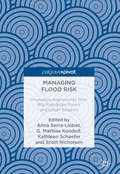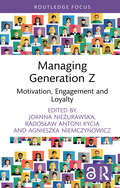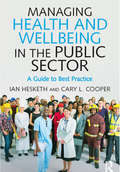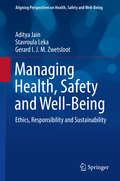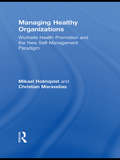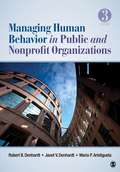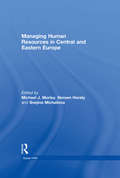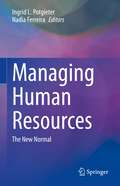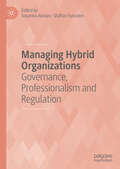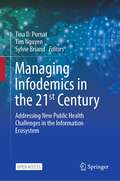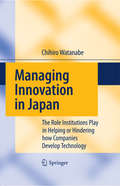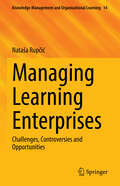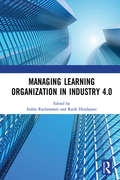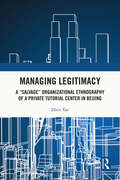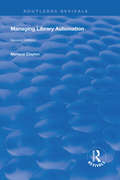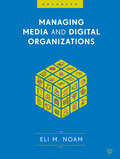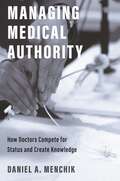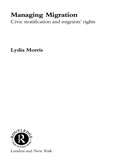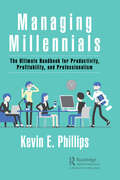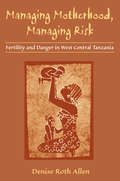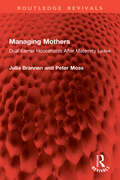- Table View
- List View
Managing Flood Risk: Innovative Approaches From Big Floodplain Rivers And Urban Streams
by Scott Nicholson G. Mathias Kondolf Anna Serra-Llobet Kathleen SchaeferThe past half century has seen an evolution in thinking from ‘flood control’ to ‘flood risk management’, recognizing that risk results from both hazard and vulnerability. Rather than rely only on engineering structures to reduce flood magnitude or extent, recent policies emphasize avoiding construction in flood-prone areas (or moving people from floodplains), reducing impacts on exposed populations through early warning systems, and insurance to aid in recovery. Implementing this new approach faces many challenges but also offers opportunities for synergies, as described in this book for a range of large floodplain rivers and smaller urban streams across North America and Europe. This book is unique in presenting the voices of those on the front lines of implementing a new paradigm in flood risk management, each river with a unique set of challenges and opportunities derived from its specific geography as well as differences in governance between the American and European contexts.
Managing Fragmentation: An Area Child Protection Committee in a Time of Change (Routledge Revivals)
by Adrian BartonThis title was first published in 2002: The rise of New Public Management and the fragmentation of agencies that resulted, created unprecedented new tensions and problems in multi-agency work. This book provides a fascinating insight into the workings of a large multi-agency committee, exploring the manner in which different agencies brought their own agendas, organizational structures and world-views to a multi-agency forum and expected working relationships to be relatively problem free. Charting the development of child protection in the UK, it explores the problems and prospects of both multi-agency working and new public management, under the auspices of joint working initiatives. It offers a unique insight into how members of an area child protection committee viewed working with others, drawing on detailed comments and quotes from those directly involved.
Managing Future Challenges for Safety: Demographic Change, Digitalisation and Complexity in the 2030s (SpringerBriefs in Applied Sciences and Technology)
by Corinne Bieder Hervé Laroche Jesús Villena-LópezThis open access book addresses the future of work and industry by 2040—a core interest for many disciplines inspiring a strong momentum for employment and training within the industrial world. The future of industrial safety in terms of technological risk-management, although of obvious concern to international actors in various industries, has been quite sparsely addressed. This brief reflects the viewpoints of experts who come from different academic disciplines and various sectors such as oil and gas, energy, transportation, and the digital and even the military worlds, as expressed in debates and discussions during a two-day international seminar. The contributors address such questions as:What influence will ageing and lack of digital skills in the workforce of the occidental world have on safety culture?What are the likely impacts of big data, artificial intelligence and autonomous technologies on decision-making, and on the roles and responsibilities of individual actors and whole organizations?What role have human beings in a world of accelerating changes?What effects will societal concerns and the entrance of new players have on technological risk management and governance?Managing Future Challenges for Safety will interest and influence researchers considering the future effects of a number of currently developing technologies and their practitioner counterparts working in industry and regulation.
Managing Generation Z: Motivation, Engagement and Loyalty (Routledge Open Business and Economics)
by Agnieszka Niemczynowicz Radosław Antoni Kycia Joanna NieżurawskaGeneration Z (Gen Z) is the young generation born between the mid-1990s and 2010s. They are now entering the market and starting their first jobs. Therefore, managers must shape the company workplace environment to encourage young employees to work efficiently and connect their future with the company. Only then will both managers and employees share mutual satisfaction from collaboration and aim at the common target, which should be the prosperity of the company. This book presents research results and techniques for analysing the working expectations and needs of Gen Z. The analyses were made in various countries in Europe: The Czech Republic, Latvia, Poland, and Portugal. The book contains chapters that present the analysis results and technical chapters that outline modern methods of analysis of management data, including tutorial chapters on machine learning, which currently makes a strong appearance in research in various disciplines. This volume will be of interest to researchers, academics, practitioners, and students in the fields of management studies, research methods, and human resource management.
Managing Health and Wellbeing in the Public Sector: A Guide to Best Practice
by Cary L. Cooper Ian HeskethAs governments throughout the world experience increasing fiscal challenges, the pressures on public sectors to streamline services and harness technological advances is unprecedented. Many have undergone huge budgetary cuts as a result, but what are the effects of this intense organisational change on such a large and varied workforce? And how can managers within the public sector meet the challenge of delivering services whilst maintaining the health and wellbeing of staff tasked with carrying out the work? Managing Health and WellBeing in the Public Sector: A Guide to Best Practice is the ideal companion to any manager in these challenging times. Exploring the realities of working in the public sector, and those factors which can add meaning and purpose to working life, the book provides managers with a practical toolkit for creating the best working environment, as well as nurturing resilience and motivation within their staff. Written by two authors with a lifetime of experience in the field, the book also examines why promoting occupational health and wellbeing is beneficial to organizations, drawing on a wealth of international research to support this argument. It concludes with a series of case studies in which an international range of public sector managers discuss initiatives they have implemented, and how successful they have been. This is the ideal companion for any manager working in the public sector. It will also be instructive reading for students or researchers of occupational or organizational psychology, as well as HRM.
Managing Health, Safety and Well-Being: Ethics, Responsibility And Sustainability (Aligning Perspectives On Health, Safety And Well-being Ser.)
by Stavroula Leka Aditya Jain Gerard I.J.M. ZwetslootTo achieve sustainable progress in workplace and societal functioning and development, it is essential to align perspectives for the management of health, safety and well-being. Employers are responsible for providing every individual with a working environment that is safe and does not harm their physical or mental health. However, the current state of the art indicates that approaches used to promote health, safety and well-being have not had the anticipated results. At the level of the enterprise it is widely understood and accepted by all stakeholders that employers share the responsibility of promoting and managing the health of their workers. Evidence indicates that most employers put in place procedures and measures to manage workers’ health and create healthy workplaces to meet legal requirements, as a response to requests by employees, as a need to improve company image/reputation, and to improve productivity. This highlights that in addition to legal requirements, the key drivers for companies also include the ethical and business case. While much has been written about role of legislation and the business case for promoting health, safety and well-being, not much is known about the ‘ethical case’ for promoting employment and working conditions. In this context, this book examines the potential of the link between responsible and sustainable workplace practices, human rights and worker health, safety and well-being and explores how complementary approaches can be used to promote employment and working conditions and sustainability at the organizational level. It offers a framework for aligning different approaches and perspectives to the promotion of workers’ health, safety and well-being and provides recommendations for introducing such an approach at the enterprise level.
Managing Healthy Organizations: Worksite Health Promotion and the New Self-Management Paradigm (Routledge Studies in Human Resource Development)
by Mikael Holmqvist Christian MaraveliasDuring the past two decades, corporate management has come to take an active role in health promotion programming for employees, offering health education, screenings, therapy, and even leisure initiatives. However, little attention has been given to how contemporary worksite health programs in fact blur the traditional distinction between work and private life. This has resulted in that little research on the other side of the work-health nexus: how employers factor health considerations into workforce management and productivity control. With the advancement of "work-site health promotion" in contemporary organizations, Holmqvist and Maravelias argue that this narrow focus, and the typical uncritical standpoint towards initiatives which are taken in the name of employees’ health, is inadequate. At a more fundamental level, the advancement of work-site health promotion may be a sign of a new or altered corporate health ethic: in contrast to the old corporate health ethic that was narrow and specific to the workplace, the new corporate health ethic appears to judge the ‘whole employee’ and especially what the whole employee may become; the risks one faces and the abilities one has to shoulder the responsibility for developing into a real corporate value. The authors suggest that health experts’ work is closely aligned with problems relating to the general management of organizations. Through a focused appraisal of this central albeit neglected occupational group in management studies, this book tries to explore and understand in some depth situations and experiences that are of general interest and concern in our society.
Managing Human Behavior in Public and Nonprofit Organizations
by Robert B. Denhardt Janet V. Denhardt Maria P. AristiguetaThe only text in management and organizational behavior to focus on public organizations, nonprofit organizations, and school systems, Managing Human Behavior in Public and Nonprofit Organizations fosters competency in critical management and leadership skills including communication, motivation, teamwork, group dynamics, and decision-making. Cases, self-assessment exercises, simulations, and evaluative instruments provide students the opportunity to experience the applied side of theories and to learn both cognitively and experientially. The Third Edition covers recent developments in the field including the emergence of "positive organizational behavior. "
Managing Human Resources in Central and Eastern Europe (Global HRM)
by Michael J. Morley Snejina Michailova Noreen HeratyAgainst the backdrop of ancient cultures, a communist legacy and eventual institutional atrophy, many of the societies of Central and Eastern Europe have pursued aggressive development trajectories since the early 1990s. This part of Europe is now characterized by a rising economic heterogeneity and a rapidly changing socio-cultural context, underscored by waves of restructuring, privatization, increasing foreign direct investment and an emerging individualism. While there has been a growing interest in the transition economies in the past number of years, the contemporary nature of human resource management in these societies is not well-documented. This long-awaited text seeks to chart the contemporary landscape of HRM in this region. In doing this, it describes key aspects of the transition process as experienced in each of the economies under consideration, as well as describing key legislative and labour market developments and reforms. Finally, it discusses key trends in HRM policy and practice.
Managing Human Resources in North America: Current Issues and Perspectives (Global HRM)
by Steve WernerThis unique text covers the key issues in North American human resources today. Providing an overview of new and emerging issues in North American Human Resource Management (HRM), the chapters are divided into three parts. The first part examines how changes in the business environment have affected HRM; the second part looks at topics that have escalated in importance over the last few years; and the third analyzes topics that have recently emerged as concerns. Each chapter is authored by a leading figure in the field and features case vignettes to provide practical illustrations of the points in hand. The chapters also conclude with guidelines to help HR professionals deal with the issues raised. A Companion Website featuring online lecturer and student resources is available for this text and can be visited at www.routledge.com/textbooks/0415396867. Managing Human Resources in North America is a core text for current issues in HRM courses in North America and a supplementary text for students studying international HRM in other countries. It will be invaluable reading for all those studying HRM in North America or currently working in the field.
Managing Human Resources: The New Normal
by Ingrid L. Potgieter Nadia FerreiraThis book volume crafts an exciting, original account on the changes and requirements on managing human resources within the context of the new normal. Chapters in this book report on current research on the key constructs and processes underlying the management of human resources, both on an organisational strategic level as well as an individual employee level. Chapters compare current research trends in terms of future potential directions for the management of human resources within the context of the new normal. The book also critically evaluates the relevance, applicability and utility of the research findings and theoretical premises in various classical, current and potential emerging issues for research and practice in the smart digital technological world of work for human resource management. This volume approaches the concept of managing human resources with the new normal working context from a number of different angles. The authors have categorized them as conceptualizing human resource management in the context of the new normal (Part I), the critical issues in understanding the dynamics of strategic human resources management (Part II), critical issues in understanding the impact of the new normal on the psychology of employees (Part III), and the impact of the new normal on individuals with special needs (Part IV). The book ends in Part V of the volume, with an integrated reflection and conclusion on emerging issues for research and practice. The primary audience for this book volume is advanced undergraduate and postgraduate students in human resource management, as well as scholars in both academic and new normal working contexts. Human resource management practitioners will also have an interest in this book volume.
Managing Hybrid Organizations: Governance, Professionalism and Regulation
by Susanna Alexius Staffan FurustenA much-needed addition to literature, this timely edited collection aims to provide clarity and understanding on how modern organizations work. The authors explore the characteristics of hybrid organizations in contemporary society, taking into account the complex societal challenges that face businesses today. Arguing that hybrid organizations are in fact not a new phenomenon, this thought-provoking collection goes beyond existing research and re-evaluates our traditional understanding of this concept. Scholars of organization, management and innovation will find this book an insightful read, as it sheds light on the fundamental aspects that shape today’s hybrid organizations.
Managing Infodemics in the 21st Century: Addressing New Public Health Challenges in the Information Ecosystem
by Tina D. Purnat Tim Nguyen Sylvie BriandThis open access book on infodemic management reviews the current discussions about this evolving area of public health from a variety of perspectives. Infodemic management is an evidence-based practice underpinned by the science of infodemiology that offers guidance to better manage pandemic and epidemic risks and more quickly tackle new and resurgent health threats. Infodemic management has added much visibility and recognition for the importance of social-behavioural sciences, health communication, participatory and human-centered approaches, and digital health as complementary scientific and practical approaches that also must be strengthened in public health practice through a whole-of-society and whole information ecosystem approach. This volume makes a case that health of the information ecosystem in the digital age has emerged as the fourth ecosystem that public health is challenged by, along with the triad of environment-human-animal health. The book brings together scientists and practitioners across disciplines to offer insights on infodemic management. The tools, methods, analytics, and interventions that they discuss in the context of acute health events also can be applied to other public health areas. Topics covered include: People's Experience of Information Overload and Its Impact on Infodemic HarmsSmart Health! Expanding the Need for New LiteraciesTo Debunk or Not to Debunk? Correcting (Mis)informationPartnering with Communities for Effective Management of Health Emergencies Managing Infodemics in the 21st Century is required reading for public health practitioners in need of an overview of this evolving field of practice that has made major scientific and practical leaps forward since early 2020. Global, regional, and local health authorities are increasingly recognizing the need to expand their capacities for infodemic management in their efforts to better prepare for future health emergencies. This book is the resource they need to build toward a mature infodemic management process. The text also can be used as supplemental reading for graduate programs and courses in public health.
Managing Innovation in Japan
by Chihiro WatanabeWhy do some country's hi-tech firms innovate better than others? Why did hi-tech firms from the United States outperform such Japanese companies in the 1990s? Through a wealth of empirical evidence, the book compares the development trajectory of manufacturing technology and information technology both between Japanese companies and between companies based in the US, Europe, Australia, India and China. This book shows that institutional systems such as culture, tradition, consumers and local business practices play key roles in how companies develop technology. These factors also influence the very characteristics of the products that the hi-tech firms produce. With a number of case studies the author demonstrates how the most successful and innovative companies recognize these roles and incorporate them into their practices.
Managing Learning Enterprises: Challenges, Controversies and Opportunities (Knowledge Management and Organizational Learning #14)
by Nataša RupčićThis book provides an overview and a critical analysis of prior research and practice insights in the field of learning organizations and learning enterprises. However, it also represents the author's own findings and reflections on various dimensions and perspectives of a learning organization, offering solutions in response to previous findings and their critical evaluation. It reflects the time in which it was written, characterized by concerns about reaching the limits of growth and the potential collapse of the world under the burden of pollution and a growing population. Instead of advocating for greater control and regulation, this book presents a different perspective on the solution: the development and transformation of collective consciousness.
Managing Learning Organization in Industry 4.0: Proceedings of the International Seminar and Conference on Learning Organization (ISCLO 2019), Bandung, Indonesia, October 9-10, 2019
by Ratih Hendayani Indira RachmawatiThe proceedings of the 6th International Seminar & Conference on Learning Organization (ISCLO) with the theme “Enhancing Organization’s Competitiveness through Knowledge Sharing and Learning Culture in the 4.0 Era” provides research results from scientists, scholars and practitioners, exchanging information and discussing the latest issues related to topics such as Marketing, Human Resources, Industrial Behavior and Knowledge Management, Entrepreneurship and Strategic Management, IT and Operations Management Economics, Financial and Accounting. These papers will contribute to the enhancement of the organization's competitive advantage with technology serving as a supporting system for knowledge sharing and learning culture. These proceedings will be of interest to scholars, practitioners, government and the industry employees, taking part in increasing Global Competitiveness in the coming years.
Managing Legitimacy: A “Salvage” Organizational Ethnography of a Private Tutorial Center in Beijing
by Zhen TaoFrom an out-of-school perspective, the book studies private supplementary tutoring, also widely known as shadow education within the Chinese education landscape.The author presents an organizational ethnography of Smart English, a private English tutoring center in Beijing. Using the concept of “organizational legitimacy” from organizational institutionalism as its framework, the study provides a detailed account of the center’s daily operations. It examines how the organization manages its legitimacy while navigating regulations, providing private supplementary tutoring, and addressing public skepticism. The book documents the typical operations of such institutions in Chinese mainland before stringent regulations disrupted their activities, serving as a “salvage” record.This book enriches educational ethnographies and will appeal to academics of shadow education, Chinese education, and ethnography.
Managing Library Automation: Second Edition (Routledge Revivals)
by Marlene ClaytonFirst published in 1992, Managing Library Automation provides a concise, easy-to-read guide to the main factors which librarians and information workers should be aware of when considering computerization. This second edition has been revised and updated with the assistance of Chris Batt to ensure a fresh perspective. The book retains, however, its original brief of not attempting to cover every detail of an extensive topic, but instead, gives the essential facts and indicates significant trends. Historical accounts have been kept to the minimum and no attempt has been made to describe or explain computing techniques except where an understanding of these assists the effective use of systems by librarians. References to further reading are given where appropriate. The book begins by setting library automation within the context of a wider strategy for the use of Information Technology. The importance of careful planning – the first skill of management – is stressed. Subsequent chapters explore the ‘nuts and bolts’ of hardware and software and reveal some of the more significant changes that have now taken place in the five years since the previous edition was published. The ‘human’ aspect of automation is considered throughout the book. Although a more commonplace activity than five years ago, the successful integration of automation into the total library system is still a considerable managerial achievement.
Managing Media and Digital Organizations
by Eli M. NoamWhat does it take for success in the media business? Creativity, innovation, and performance, of course. Plus experience and good judgment. However, it also requires an understanding of the principles and tools of management. This book summarizes the major dimensions of a business school curriculum and applies them to the entire media, media-tech, and digital sectors. Its chapters cover—in a jargonless, non-technical way—the major management functions. First, creating a media product: the financing of projects and the management of technology, HR, production operations, intellectual assets, and government relations. Second, harvesting the product created: market research, marketing, pricing, and distribution. And third, is the control loop: media accounting and strategy planning. The book’s interdisciplinary approach goes beyond an industry-by-industry coverage and centers around management functions. In the process, this book becomes an indispensable resource for those aiming for a career in the media and digital field, both in startups and established organizations. It is also a work that helps advance the entire field—the management of information resources and products—to a more central role in business analysis. This book is designed to help those already in the sector or those joining it to become creative managers and managerial creatives. It aims to make managers in this field more knowledgeable, less blinded by hype, more effective, more productive, and more responsible.
Managing Medical Authority: How Doctors Compete for Status and Create Knowledge
by Daniel A. MenchikHow the authority of medicine is continuously shaped by relationships among physicians, industry, colleagues, and organizations Exploring how the authority of medicine is controlled, negotiated, and organized, Managing Medical Authority asks: How is knowledge shared throughout the profession? Who makes decisions when your heart malfunctions—physicians, hospital administrators, or private companies who sell pacemakers? How do physicians gain and keep their influence? Arguing that medicine’s authority is managed in collegial competition across venues, Daniel Menchik examines the full range of stakeholders driving the direction of the field: medical trainees, clinicians, researchers, administrators, and even the corporations that develop groundbreaking technologies enabling longer and better lives.Menchik takes us into Superior Hospital to witness surgeries and executive negotiations. He moves outside the hospital to watch professional committees craft standards for treatments, case management, and professional ethics. At industry-sponsored meetings, he observes company representatives who train some experienced doctors on their technologies, while deterring others who they think might injure patients. Using an innovative ethnographic approach tying individual actions and their collective consequences, he considers how stakeholders ally across the various venues of medicine, even as they are sometimes pressed into competition within those venues. Menchik finds that these alliances and rivalries strengthen the authority of medicine as a whole. From place to place, and group to group, we see how a medical specialty renews and reinvigorates itself.Beginning within the walls of the hospital, and moving to the professional and commercial venues that shape it, Managing Medical Authority offers an agenda-setting take on the social organization of medical authority.
Managing Migration: Civic Stratification and Migrants Rights
by Lydia MorrisNation States now increasingly have to cope with large numbers of non-citizens living within their borders. This has largely been understood in terms of the decline of the nation state or of increasing globalisation, but in Managing Migration Lydia Morris argues that it throws up more complex questions. In the context of the European Union the terms of debate about immigration, legislation governing entry, and the practice of regulation reveal a set of competing concerns, including: *anxiety about the political affiliation of migrants *a clash between commitment to equal treatment and the desire to protect national resources *human rights obligations alongside restrictions on entry. The outcome of these clashes is presented in terms of an increasingly complex system of civic stratification. The book then moves on to examine the way in which abstract notions of rights map on to lived experiences when filtered through other forms of difference such as race and gender. This book will be essential reading for students and researchers working in the areas of migration and the study of the European Union.Lydia Morris is Professor of Sociology at the University of Essex.
Managing Millennials: The Ultimate Handbook for Productivity, Profitability, and Professionalism
by Kevin E. PhillipsThe Millennial workforce has different goals and objectives than previous generations and possesses a unique perspective that is unlike any other employee group. Nevertheless, instead of incorporating a management style that is conducive to getting the best out of Millennials, business leaders incorrectly attempt to manage this subset of the workforce the same way they manage employees from previous generations. This must change! Archaic methods of management do not deliver success with a new breed of employee. Instead, the outdated model leaves Millennials uninspired and lacking the desire to produce results. To get the best out of Millennials, it is imperative for leaders to modify their current management style. With over 55 million Millennials working in the United States, the largest demographic in the workplace, it is critical that they are managed effectively if companies are going to succeed. Managing Millennials: The Ultimate Handbook for Productivity, Profitability, and Professionalism delivers a profound understanding of what motivates Millennials, generates increased awareness of the different ideologies and preferences each generation in the workplace values, and most importantly, provides specific actions you can use to understand and motivate Millennials and transform your organization.
Managing Moral Emotions in Divided Politics: Lessons from Hungary’s 2022 General Election Campaigns
by Gabriella SzabóThis book explores how to identify and understand moral emotions—shame, guilt, pride, and hubris—in political messages and news media. Recognizing these emotions is crucial for assessing morality's role in public discourse, particularly as moral debates have deepened public divides on issues like abortion, migration, LGBTQ+ rights, and freedom of speech. These debates fuel political struggles between groups with different social values and moral intuitions, especially during election campaigns where moral conflicts are used to distinguish opposing forces. In these moral conflicts, each ideological camp seeks to affirm its legitimacy while questioning its opponents' reputations. Thus, understanding morality is vital for those interested in contemporary public discourses in divided nations. This book stimulates discussion on emotion-based morality, moral language, and discursive moral regulation in politics. It offers innovative analytical frameworks to study how political communication contributes to public moralization. The book combines descriptive, explorative, and comparative approaches to summarize findings from mixed-method analyses (qualitative and quantitative, textual and visual, content and survey) of moral emotional messages and media portrayals of prime minister candidates during Hungary's 2022 General Election Campaigns. Hungary serves as an illustrative case due to increasing concerns about the moral status of its political elite and extreme hostility between political blocs, leading to polarized views on governance. This book will be of interest to academics specializing in empirical moral studies and investigating public discussions in contentious and polarized societies.
Managing Motherhood, Managing Risk: Fertility and Danger in West Central Tanzania
by Denise Roth AllenAn investigation of the consequences resulting from fertility-related development interventions in Tanzania
Managing Mothers: Dual Earner Households After Maternity Leave (Routledge Revivals)
by Peter Moss Julia BrannenFirst published in 1991, Managing Mothers (now with a new preface by the authors) provides a detailed, authoritative inside story of the lives of parents, and particularly mothers, who return to work after the birth of a first child. It is based on a study of couples who have combined the transition to parenthood with two full-time jobs in the labour market. The authors provide extensive personal accounts from interviews and statistical data that shed light on the experience and significance of this growing social group. They reveal that mothers are the main managers of the dual-earner lifestyle; hence, they are the principal characters in this story as the authors explore women’s occupational mobility, their social networks, social and emotional support, and psychological health.The book exposes a variety of constraints upon women: the continuing power of unsupportive ideologies concerning breadwinning, marriage and family life; the failure of government to organize good quality childcare; the failure of employers to make provisions that would enable parents to fulfil their employment and domestic responsibilities; and the failure of husbands to take an equal share in household work. An understanding of these constraints is essential if the increased need for women in the labour market is to lead to better and more equal employment for women and the removal of the ‘double burden’ that weighs so heavily on many working mothers. This volume will be a beneficial read for students and researchers of sociology and psychology.
